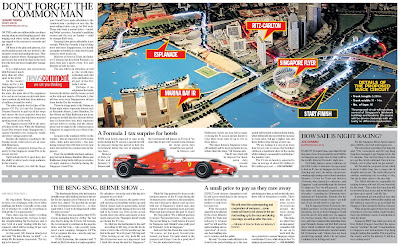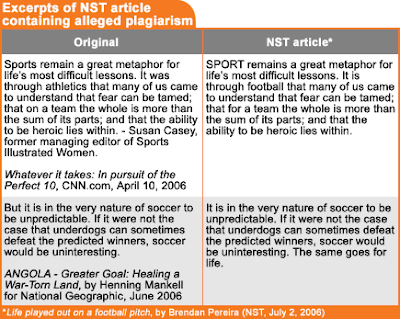Here's an interesting article from Tony Pua, Lim Kit Siang's spanking new DAP economic advisor. Regardless of his political leanings, he speaks of an issue that I'm intimately familiar with, a phenomenon which I am currently living out.
Although he does not colour his article with racial nuances (I, on the other hand, have no such qualms), he speaks of the unstemmed flow of non-Malay brains (and brawn as well, judging by the thousands of workers trundling across the causeway in blue factory buses and motorcycles each morning) from Malaysia to Singapore.
The sad part is that this happens for no better reason than the fact that the Malay-sian political and social establishment insists that all aspects of Malaysian life be dominated by discriminatory racial quotas and preferences. If these quotas and preferences were based on race-blind need, I'd fall over myself in support of it. But alas they are not. They are based on skin colour and a false social contract used like a FRU truncheon on non-Malay skulls.
From the day that he's born until the day he leaves this world, each Malaysian is constantly reminded that he is either born to enjoy 'special privileges' or born to foot the bill for it. And as if this wasn't enough, fundamentalist Islamisation is increasingly encroaching upon Malaysia's hereto secular multi-religious society. Is it any surprise that the drain is getting deeper and steeper?
Human capital the key to growth
Tony Pua
http://www.nst.com.my/Current_News/NST/Sunday/Columns/20070429080235/Article
AS an economics enthusiast, I’ve often been asked, "What determines the size of an economy?"
Is it dependent on rubber and high oil palm prices? Or the size of our oil and gas resources? Or instead, is it dependent on land area and population?
Malaysia is extremely well endowed with fertile land, large tracts of tin mines as well as some of the highest quality petroleum reserves in the world. Singapore, our neighbour down south, however, is not as fortunate.
To put it bluntly, it is a tiny island, 480 times smaller than us, completely unsuitable for commercial plantation and lacking any natural resources. Even its population today of some four million, excluding migrant workers, is one-sixth of Malaysia’s population.
If the size of an economy is dependent on the factors highlighted above, such as arable land and natural resources, Malaysia’s economy should be many times the size of Singapore’s. However, reality paints a very different picture.
While Malaysia’s economy of US$130 billion (RM444 billion) is still larger than Singapore’s US$117 billion, the latter is only smaller by some 11 per cent. And if the rate of growth currently experienced in both countries persists for the next decade, then our tiny neighbour could soon boast a larger economy than Malaysia.
How is it even possible for a country with a sheer lack of resources and land mass to do so well? How did a country that was barely half our economic size in the early 1980s catch up within such a short period of time?
Through a simple exercise of elimination, it all boils down to a simple single factor — human capital.
Singapore’s near compulsive obsession with human capital, both in terms of enhancing its local citizenry as well as attracting the best foreign talent, has probably resulted in the highest concentration of top brains per square foot in the region, if not the world.
Every year, for example, Singapore provides financial incentives in the guise of the Asean Scholarship to hundreds of Malaysian students at all levels — post-UPSR, post-PMR, post-SPM and post-STPM — to study in some of the best schools on the island.
I was a fortunate beneficiary of such a scholarship after completing my primary school education in Batu Pahat. Unlike me, however, and unfortunately for Malaysia, most of my peers have chosen to work or even settle permanently in the island nation.
My best friend in primary school, who received the same scholarship after Form Three, went on to pursue his degree at Oxford University on a Neptune Orient Lines (NOL) scholarship. He now works for them, one of the largest shipping companies in the world, as an expatriate country manager in Vietnam.
Another fellow scholar graduated from London School of Economics (LSE) on a scholarship from Singapore Airlines (SIA). Most impressively, at the young age of 36, he has been appointed the chief executive officer of SIA’s subsidiary airline, SilkAir, as of March this year.
And when I had my annual Chinese New Year reunion with my home town classmates this year, I was heartbroken to hear that one of them, who is an academic with one of Singapore’s institutions of higher learning, had just renounced his Malaysian citizenship to become a Singaporean.
These are not my only examples, and you can be assured that I do not have a monopoly on talented friends. A local senior law lecturer recently commented that the Universiti Malaya (UM) law faculty was depleted of quality academics because Malaysians make up some 40 per cent of law lecturers at the National University of Singapore.
While Malaysia Airlines (MAS) struggled over the past decade with cumulative losses in excess of RM1 billion, SIA, which split from MAS in 1972, shone brightly as one of the most profitable airlines in the world. Ironically, it was an outstanding Malaysian and a former academic with UM, Dr Cheong Choong Kong, who led SIA to an unbroken 31-year record of profitability through turbulent economic times before his retirement in 2003.
Hence, when Prime Minister Datuk Seri Abdullah Ahmad Badawi rolled out the Ninth Malaysia Plan (9MP) with an emphasis on human capital, I was pleased to a certain extent. The 9MP had an entire chapter dealing with human capital.
The human capital policy thrusts called for the creation of "universities of international standing and ensuring that tertiary institutions meet the needs of employers" and "nurturing an innovative society with strong science and technology capabilities and the ability to acquire and apply knowledge", among other things.
However, as part of the thrust, there was only a cursory mention of a "National Brain Gain Programme" to be spearheaded by a focal point at the Science, Technology and Innovation Ministry.
There was no discussion on the issue of attracting and retaining local and foreign talents, a critical element in developing Malaysia’s human capital. It is extremely important for the government to recognise the fact that the development of human capital in Malaysia is intrinsically and inexplicably linked to the issue of brain gain and reversing brain drain.
An effective human capital development policy is not just limited to building more schools and universities, or hiring more teachers and lecturers.
Singapore, for example, has only half our ratio of universities to the population. Yet, two out of their three universities are recognised as among the Top 50 in the world.
The government must give thorough consideration to the all-important qualitative element of uncompromising search for the best-qualified educators and an education policy which rewards academic rigour, critical thinking and analytical intelligence.
Without such a policy structure and ingrained culture in place, it is unsurprising that many young and particularly talented Malaysians will seek out the "borderless" global academic environment in which their potential can be fully harnessed.
Concurrently, the country’s education policy must be complemented with an equally competitive economic environment which provides these talents with fair and equal opportunities to grow in their careers, contribute economically and be compensated accordingly — in order to retain these talents.
Our competitors’ ability to attract young Malaysians, provide undisputed world-class quality education and offer a conducive economic environment has clearly resulted in our loss.
It is hard to imagine that my friends, who have done extremely well for themselves overseas, would have had the same opportunities in equivalent entities in Malaysia.
The government must be commended for highlighting the importance of human capital in the economic growth and development of the country. However, if the government is serious about raising the quality of human capital, much more needs to be done to create a holistic and integrated plan that will honestly appraise and critically examine the quality of Malaysia’s educational institutions.
We must also identify the underlying factors, perceived or otherwise, of the lack of equal opportunities and glass ceilings as well as limited career advancement based on merit in many of our "commercial" organisations.
Should our ample pool of potential talent be fully harnessed, attracted and retained, coupled with our rich and God-given natural resources, then surely we can stay well ahead of our competitors, eliminate poverty sooner and become a truly developed nation by 2020.
>>>>> Tony Pua, who has a degree in Philosophy, Politics & Economics from Oxford University, is the economic adviser to DAP’s secretary-general. He blogs at tonypua.blogspot.com






























